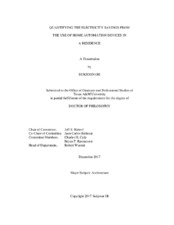| dc.description.abstract | This study quantifies the electricity savings to homeowners when they install and use Home Automation Devices (HADs), which are also called Internet of Things (IoT), in a residence. To accomplish this study, new analysis methods were developed that have built on and enhanced the features of existing energy analysis methods. A new inverse approach and a new two-way, calibrated simulation approach were combined to analyze the electricity savings from the installation and use of HADs. This study found that few of the previous studies about HADs that were reviewed developed methods for specifically quantifying the weather-normalized, hourly electricity savings to homeowners from the use of HADs. The review of the literature did find that homeowners using HADs wanted to use them automatically, without changing their lifestyle or experiencing discomfort, when turning on or turning off devices. Therefore, this study developed new, non-intrusive methods to help quantify the electricity savings to homeowners from the use of HADs using a combination of Smart Meter (SM) data and the corresponding weather data to analyze the weather-normalized savings from residences equipped with HADs.
First, a non-intrusive method was developed to automatically detect and quantify potential electricity savings of HADs using hourly electricity use data recorded by an SM (i.e., Level 0 Analysis) before the retrofit. To accomplish this, both an event detection process and an energy quantification process were developed. Second, a calibrated building energy simulation model (i.e., Level I Analysis) was developed for the case-study residence to analyze selected HAD usage scenarios to better quantify the potential electricity savings to the homeowner from the use of the HADs. The calibrated simulation model was used to simulate different scenarios of thermostatically-controlled and non-thermostatically-controlled HADs. Third, an HAD was installed in the case-study house to quantify the before/after actual electricity savings from the use of the HADs (i.e., Level II Analysis). Specifically, in the case-study house, a wireless HAD thermostat with occupancy sensors was installed.
The results showed that the annual electricity savings resulting from Level 0 Analysis, Level I Analysis, and Level II Analysis were 987.8 kWh (8.3 %), 2,961.7 kWh (25.2 %), and 5,208.4 kWh (43.6 %), respectively. Differences in the savings among the three methods can be attributed to the assumptions made for each analysis as well as the limitations in the three methods. Using the Level II Analysis savings, when the costs of the new thermostat ($249) with the seven motion sensors ($237), including the installation fee ($100), were considered, the simple payback period was 1.0 year. Thermal comfort was also analyzed. The analysis showed no significant degradation of thermal comfort from the electricity savings during occupied hours. Finally, this study provides recommendations to help improve future quantification methods and reduce the uncertainty of predicting the electricity savings for residences equipped with HADs using hourly or sub-hourly electricity use data recorded by an SM. | en |


